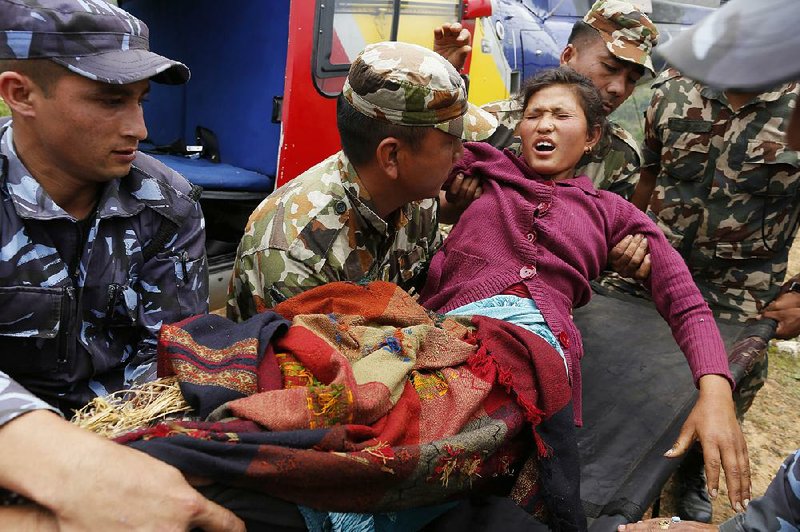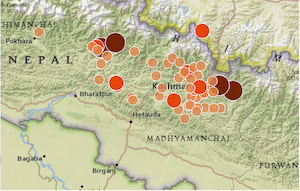GORKHA, Nepal -- Helicopters crisscrossed the mountains above a remote district Tuesday near the epicenter of the weekend earthquake in Nepal that killed more than 4,600 people, ferrying the injured and delivering emergency supplies. Officials said 250 villagers were feared missing in a new mudslide.
Two helicopters carried eight women from Ranachour village to Gorkha, the district's administrative and trading center. Two of the women clutched babies, and a third was pregnant.
"There are many more injured people in my village," said Sangita Shrestha, who was ushered into a waiting van to be taken to a hospital.
The town of Gorkha is being used as a staging post to get rescuers and supplies to those remote communities after Saturday's magnitude-7.8 earthquake.
Not far from the quake's epicenter, 250 people were feared missing after a mudslide and avalanche Tuesday, district official Gautam Rimal said. Heavy snow had been falling near the village, Ghodatabela, and the ground may have been loosened by the quake, Rimal said.
Elsewhere Tuesday, French rescuers freed a man from the ruins of a three-story Kathmandu hotel, one of a cluster near the main bus station. The man, identified as Rishi Khanal, was conscious and taken to a hospital, but no other information about him was released.
Across central Nepal, including the capital of Kathmandu, hundreds of thousands of people were still living in the open without clean water or sanitation more than three days after the quake. It rained heavily in the city Tuesday, forcing people to find shelter wherever they could.
Geoff Pinnock of the U.N.'s World Food Program was leading a convoy of trucks north toward the worst-affected areas when the rain began to pound, leaving them stuck.
"This rain has caused a landslide that has blocked my trucks. I can maybe get one truck through and take a risk driving on the dirt, but I think we'll have to hold the materials back to try to get them out tomorrow by helicopter," he said.
Aid workers who had reached the edges of the epicenter described entire villages reduced to rubble.
"In some villages, about 90 percent of the houses have collapsed. They're just flattened," said Rebecca McAteer, an American physician who rushed to the quake zone from the distant Nepal hospital where she works.
And yet, the timing of the earthquake -- near midday, when most rural people are working in the fields -- meant most villagers were spared injuries when buildings collapsed, she said. So far, police say they have 373 confirmed deaths in the Gorkha district.
"The immediate need is getting support to where it's needed, but there will be a lot of work rebuilding," said McAteer, who was heading back soon to the center of the quake zone.
Thomas Meier, an engineer with the International Nepal Fellowship who accompanied McAteer to the devastated villages, said the disaster's aftermath would stretch long into the future.
"This is a long-term emergency," he said. "This will need major attention for the next five years. People have nothing left."
Jamie McGoldrick, the United Nations resident coordinator in Kathmandu, said 8 million people had been affected by the quake, and that 1.4 million needed food assistance.
The challenge is to reach them in rugged isolated villages.
At Kathmandu airport, flights arrived with emergency aid, and helicopters carried in foreign trekkers and local villagers from quake-struck areas. Helicopters chartered by trekking companies reached the Langtang area, about 40 miles north of Kathmandu, a popular area for trekking -- a key contributor to the country's economy.
Guiding companies said Tuesday that all climbers on the Nepal side of Mount Everest had left the mountain, and the climbing season was declared over after an avalanche swept through the base camp, killing 18, after the earthquake.
A California man who had been planning to climb Mount Everest for at least a decade -- Vinh Truong of Sunnyvale, Calif. -- was among four Americans killed in the avalanche, the U.S. State Department said. Also killed were Marisa Eve Girawong and Thomas Ely Taplin. The fourth American had not been identified Tuesday.
The country's confirmed death toll rose to 4,680 Tuesday, said police Inspector Sharad Thapa at the Nepal Police Control Room in Kathmandu. Another 61 were killed in neighboring India, and China's official Xinhua News Agency reported 25 dead in Tibet.
Some 8,063 people have been injured, Deputy Inspector General of Police Komal Singh Bam said. Tens of thousands are believed to be homeless.
The United Nations said Tuesday that it is releasing $15 million from its central emergency response fund for quake victims. The funds will allow international humanitarian groups to scale up operations and provide shelter, water, medical supplies and logistical services, U.N. spokesman Farhan Haq said.
Information for this article was contributed by Todd Pitman and Binaj Gurubacharya of The Associated Press.
A Section on 04/29/2015

